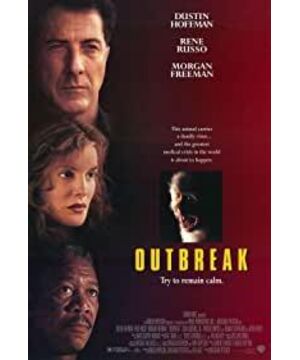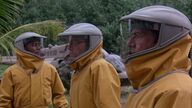The film "Outbreak" was filmed in 1995 and shows a shocking viral story. In 1967, a strange disease suddenly began to circulate in the mercenary barracks in the Motaba Valley, Zaire, Africa, and people continued to die. After the US military doctors took samples of infected blood and determined that it was a highly infectious virus, the US military dropped bombs directly on the barracks that evening, destroying the entire barracks. In 1995, this disease appeared on the African continent like a ghost. At the same time, monkeys carrying the virus entered the United States through wild animal smugglers. The mutated virus caused a lethal infectious disease, and it spread in the United States in the form of airborne transmission. Open.
Although this story is fictitious, this film provides us with a good material for understanding the virus from multiple angles.
1. Between living things and non-living things,
people always associate viruses with disease and death closely. Its ability to destroy and destroy living organisms seems to be infinite. The plague, hepatitis, AIDS and other shocking diseases are all due to some kind of virus. The result of the invasion.
The virtual virus in the movie has such characteristics, it severely damages the cells of the human body. In an hour, the cells surrounding the infected cell will completely disappear from the microscope's field of vision, not only the structure of the cell, but even the entire cell. Infected patients, early symptoms of fever and cough, accompanied by unstoppable tears, and two days later, will die of high fever and ulcers.
Over the course of a century, the scientific community’s view of the definition of a virus has continued to change. Viruses were first thought of as poisons, then forms of life, and then biochemical substances.
Viruses are just a kind of living matter between life and non-life. Its structure is extremely simple. You can say that they are just organic matter. It is as simple as having only nucleic acid molecules and proteins, or even only nucleic acids or only proteins. What causes mad cow disease is a protein-only substance. It is said to be life, but it has no genes. Under normal circumstances, it cannot be reproduced. ; If it is not a living thing, it can multiply inside the cell, causing the cell to become diseased and die. When viruses are free of cells, they cannot replicate, grow, and do not exhibit any life activities. They are no different from non-living organisms. All their life forms must be after they enter the living cells of other living organisms. Show it.
2. History repeats itself or predicts that
there have been numerous outbreaks of large-scale plagues in human history. For example, the Black Death reduced the population of Europe by a quarter in the Middle Ages. The closest one to us was the Spanish flu of 1918. In this disaster, 25 million people died. Even now, although many people have not experienced these horrible events, they still have lingering fears when it comes to mentioning them.
Another thing worthy of our attention is the frequent local outbreaks of some diseases in the past two years. For example, the mad cow disease panic in 1998, SARS in 2003, and the spread of bird flu last year are all related to the virus. Especially in 2003, the spread of SARS in China caused a very high mortality rate, which caused local panic at one time, and the economy of many regions was also hit hard.
The public's attention to the virus has therefore risen to a new level. Some people even worry that: a new large-scale infectious disease is coming again.
When watching the film "Outbreak", I admired the visionary and vision of the director Wolfgang Petersen. As I mentioned above, in the 1995 film, Petersen described such a fatal infectious disease for us. The early symptoms were high fever, cough, tears and sore body. This is exactly the same as SARS. Moreover, the speed of transmission is also very fast, because air is a very important medium of transmission. Of course, the virus in the film is highly lethal. I am very thankful that the director’s prediction has not been fulfilled. The SARS virus has not yet been so smart. Otherwise, the death toll will probably increase.
The virus carrier in the film is a monkey smuggled from Africa, which may be inspired by the discovery of AIDS. After the first case of AIDS was discovered in the United States in the early 1980s, AIDS has been seen in various countries and regions today. Coupled with the fact that sex trafficking and drug abuse continue to be banned, AIDS is on the verge of spreading. Turning to SARS again, similarly, it was confirmed that the same virus was found in the body of the civet cat shortly after the outbreak. Since the beginning of the last century, some wild animals have been hunted and killed on a large scale for economic benefit, while some gluttons have tried various game dishes at a great expense. As everyone knows, in this process, various viruses began to spread quietly among humans. People change their colors when they hear about the plague, but they completely forget that they are the culprit of this panic. This cannot but be said to be a ridiculous and sad thing.
Qiao Shiva Ridberg once said: "The single biggest threat to human ruling the earth comes from viruses." The history of mankind has been moving forward along with the history of the plague. What is told in the movie may not be a coincidental prediction, but merely a summary of historical experience.
3. Reaper's Wings:
The virus in the highly contagious and variable film is said to be able to sweep the entire United States within 48 hours if no isolation measures are taken. In reality, such infectiousness is a bit exaggerated, but we can still learn from it that the infectiousness of the virus cannot be underestimated.
We know that there are many ways of transmission of the virus. Take hepatitis B virus as an example. It can be transmitted from mother to child, body fluids, and so on. The virus in "Outbreak" is spread directly through the air, and the epidemic is due to the wide spread of the virus.
At the same time, I also noticed that in the incident in 1967, the US military stepped up to develop an antiserum to deal with the mysterious virus. As a result, when the disease rose again in 1995, the antiserum actually failed. ! After research, the researchers realized with horror that this virus has mutated, and looks the same as the original virus, and it has long been completely different when observing the surface structure carefully.
The variability of the virus is also a headache for scientists. Some scientists once said half-jokingly: "Viruses can complete the evolutionary process equivalent to tens of thousands of years for humans in a few days." This is by no means alarmist. The high variability of the virus puts great pressure on the development of anti-virus drugs. Sometimes a drug has just entered the stage of animal testing and has not yet been put on the market, and new virus variants have begun to become popular. For example, the flu that people are most familiar with, some people get it several times a year. Anyone with a little bit of scientific knowledge knows that a flu is actually the same as measles and chickenpox. If you get it once, you won't get it again in a short period of time. The recurrent flu is caused by viruses of different species or subspecies, not the same virus. The symptoms of these flus are almost similar, and the difference between the pathogenic viruses can only be distinguished by electron microscopy.
Highly infectious and variability, just like the wings of death. Many lethal viruses have such characteristics.
4. Prospects:
How to treat the virus with optimism or pessimism has become a very important issue at present. On the one hand, viruses can indeed be used by humans. On the other hand, the pathogenicity of viruses is a long-standing problem. In the process of inducing virus evolution, scientists will have accidents and produce extremely destructive new species, which is also a shadow that haunts people's hearts. . I think that we will all feel fear in the face of the harm caused by the virus, but we cannot adopt an evasive attitude just because of fear. As for the virus, we should treat it in a positive way. While studying how to control the spread of the disease, we must also study how to make it better serve humanity. I believe that virology is a science with broad prospects, and we humans will eventually achieve symbiosis with viruses. This is a feasible choice.
View more about Outbreak reviews











